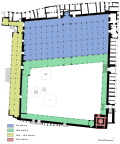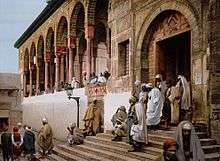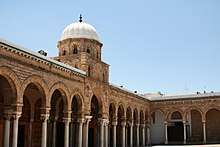Al-Zaytuna Mosque
Al-Zaytuna Mosque, also known as Ez-Zitouna Mosque, and El-Zituna Mosque (Arabic: جامع الزيتونة, literally meaning the Mosque of Olive), is a major mosque at the center of the Medina of Tunis in Tunis, Tunisia.
| Great Mosque of Al-Zaytuna | |
|---|---|
Interior courtyard and minaret | |
| Religion | |
| Affiliation | Islam |
| Status | Active |
| Location | |
| Location | |
| Architecture | |
| Architect(s) | Fat'h-Allah under the direction of the Abbasid caliph, al-Nasir[1][2] |
| Groundbreaking | 698 CE. |
| Specifications | |
| Minaret(s) | 1 |
| Minaret height | 43 meters (141 ft 1 in) |
The mosque is the oldest in the Capital of Tunisia and covers an area of 5,000 square metres (1.2 acres) with nine entrances.[1] It has 160 authentic columns brought originally from the ruins of the old city of Carthage.[2] The mosque is known to host one of the first and greatest universities in the history of Islam.[3] Many Muslim scholars were graduated from the Al-Zaytuna for over a thousand years. From Ibn 'Arafa, one of the greatest scholars of Islam, Imam Maziri,[4] the great traditionalist and jurist to the famous Tunisian poet Aboul-Qacem Echebbi and countless others all taught there.[1][5][6]
Etymology
One legend states that it was called "Mosque of Olive" because it was built on an ancient place of worship where there was an olive. However the most accepted explanation is that transmitted by the 17th century Tunisian historian Ibn Abi Dinar, who spoke about the presence of the tomb of Santa Olivia at that location. Recent research has shown that indeed this mosque was built on a Christian basilica.[7] With the advent of Islam, the church was converted into a mosque, retaining the dedication, but translating the name into Arabic.
The saint is particularly venerated in Tunisia because it is superstitiously thought that if the site and its memory are profaned then a misfortune will happen; this includes a belief that when her relics are recovered Islam will end.[8] This ancillary legend related to the discovery of the saint's relics is widespread in Sicily, however it is connected to other Saints as well.[9]
In 1402 king Martin I of Sicily requested the return of Saint Olivia's relics from the Berber Caliph of Ifriqiya Abu Faris Abd al-Aziz II, who refused him.[10] Even today the Tunisians, who still venerate her, believe that the dominion of their religion will fade when the body of the Virgin Olivia will disappear.[10]
History
Ez-Zituna was the second mosque to be built in Ifriqiya and the Maghreb region after the Mosque of Uqba in Kairouan.[5] The exact date of building varies according to source. Ibn Khaldun and El-Bakri wrote that it was built in 116 Hijri (731 C.E.) by Ubayd Allah ibn al-Habhab.[2][5][11] A second source states that the Umayyad Hisham ibn Abd al-Malik ordered the building;[5] however, Ahmed In Abu Diyaf and Ibn Abi Dinar attributed the order to Hasan ibn al-Nu'man who led the conquest of Tunis and Carthage,[5][11] and used it as a place of prayer.[12] Most scholars agree that the third possibility is the strongest by evidence as it is unlikely that the city of Tunis remained a long time without a mosque, after its conquest in 79 Hijri.[2][5][11] Thus the closest date is 84 Hijri (703 CE), and what El-Habhab did was in fact enlarge the mosque and improve its architecture.[5]
For almost two centuries (1812 - 2011), the majority of the Grand Imams of the Zitouna mosque were part of the Cherif and Mohsen families, notably including AbdelKebir Cherif, Ahmed Cherif, Mohamed Cherif, Hamda Cherif, Hassan Cherif, Mahmoud Mohsen, Mohamed Mohsen, and Mostafa Mohsen. The Cherif and Mohsen families are part of the aristocracy "Tunisoise" of Tunis Carthage; are descendants of the Islamic prophet, Mohamed; and are a dynasty of religious scholars, sheikhs, imams, and landowners. These families were founded by an ancestor who arrived in Tunis by the XIV-e century. The descendants of Sheikh Mohsen Cherif changed the line from Cherif to Mohsen, creating the Mohsen branch out of the Cherif line.
Scholarship and the University
For centuries, Qirwan was the early centre of learning and intellectual pursuits in Tunisia and North Africa in General. Starting from the 13th century, Tunis became the capital of Ifriqiya under Almohad and Hafsid rule.[13] This shift in power helped al-Zaytuna to flourish and become one of the major centres of Islamic learning, and Ibn Khaldun, the first social historian in history was one of its products.[14] The flourishing university attracted students and men of learning from all parts of the known world at the time. Along with theology; mainly the Qur'an, the university taught jurisprudence, history, grammar, science and medicine.[13] When it comes to books and libraries, Ez-Zituna libraries were the richest among North African counterparts. It had several collections totalling in the tens of thousands of books. One of its libraries, el-Abdaliyah included a large collection of rare and unique manuscripts.[15] The manuscripts covered almost all subjects and sciences, including grammar, logic, documentations, etiquette of research, cosmology, arithmetic, geometry, minerals, vocational training, etc.[16][17]
Architecture

Ez-Zituna mosque followed the design and architecture of previous mosques, mainly the Mosque of Uqba, and was an inspiration for later mosques such as the Great Mosque of Cordoba. The courtyard is accessible via nine lateral doorways and forms a rectangle surrounded by galleries supported by columns made variously of marble, granite or porphyry and which were taken from ancient monuments (primarily from Carthage), as were those in the prayer hall.[2] The square minaret rises from the northwest corner of the courtyard. Built in 1894, the minaret is 43 meters (141 ft) high[11] and imitates the decoration of the Almohad minaret of the Kasbah Mosque with its limestone strap-work on a background of ochre sandstone.[2] Presidents Bourguiba and Ben Ali carried out major restoration work and rehabilitation, especially during the 1960s and 1990s.[12] The dome was added by the Zirids around 991. A beautiful structure about 12 metres in height and 4 metres in width, the dome is considered to be one of the most beautiful domes in Tunis. It fuses Fatimid structural and decorative elements from North Africa as well as Cairo, and has designs similar to the Al Anwar Mosque in cairo.
Image gallery
| Wikimedia Commons has media related to Zaytuna Mosque. |
 Ez-Zituna mosque in 1880
Ez-Zituna mosque in 1880 Photochrom print of the main entrance in 1890
Photochrom print of the main entrance in 1890- Colonnade abutting the eastern hall
- Courtyard and sundial
 Colonnade abutting the prayer hall
Colonnade abutting the prayer hall- Minaret after 1894
 One of the mosque's doors
One of the mosque's doors
See also
- List of the oldest mosques in the world
References
- Achour, M.A. (1991). "Djami al Zaytuna, al-ma lamu wa fidjaluhu (The Zaytuna Mosque, the monument and the men)". Tunis. Cite journal requires
|journal=(help) - "Great Mosque of Zaytuna". Museum With No Frontiers.
- "About Zaytuna Institute". Zaytuna Institute of California. Archived from the original on 2009-02-27.
- From Sicilian city of Mazara (today Mazara del Vallo).
- "Al-Zaytuna Mosque through History". Al-Zaytuna Mosque. Archived from the original on 2010-01-27. Retrieved 2009-02-06. Cite journal requires
|journal=(help) - "Al-Zaytuna Theological and Scientific Influence on the Islamic World". Al-Zaytuna Mosque. Archived from the original on 2010-05-12. Retrieved 2009-02-06.
- Mohamed Béji Ben Mami. Great Mosque of Zaytuna. Discover Islamic Art – Virtual Museum.
- (in Italian) S. ROMANO. "Una santa palermitana venerata dai maomettani a Tunisi". Archivio storico siciliano, XXVI (1901), pp. 11–21.
- cfr. també F. SCORZA BARCELLONA. "Santi africani in Sicilia (e siciliani in Africa) secondo Francesco Lanzoni". Dins: Storia della Sicilia e tradizione agiografica nella tarda antichità. Atti del Convegno di Studi (Catania, 20–22 maggio 1986), a cura de Salvatore Pricoco. Catanzaro 1988, pp. 37–55.
- (in Italian) Daniele Ronco (2001). Il Maggio di Santa Oliva: Origine Della Forma, Sviluppo Della Tradizione. ETS, Pisa University, IT. 325 pages. pp. 18–19.
- (in Italian) Sant' Oliva di Palermo Vergine e martire. SANTI, BEATI E TESTIMONI. 10 giugno. Retrieved: 02 February, 2015.
- "Jemaâ Ezzitouna". Municipality of Tunis.
- "Lieux de culte Municipalité de Tunis" (in French). Government of Tunis. Archived from the original on August 11, 2009. Retrieved July 23, 2010.
- Deeb, Mary J. "Ez-Zituna; op cit;": 374. Cite journal requires
|journal=(help) - Charnay, Jean-Paul (January–February 1979). "Economy and Religion in the Works of Ibn Khaldun". the Maghreb Review. 4 #1: 1–25.
- M.J. Deeb (1995). "Ez-Zituna". In J.L. Esposito (ed.). The Oxford Encyclopaedia of the Modern Islamic World. 4. Oxford University Press. p. 374.
- Abd el-Hafiz, Mansour (1969). Fihris Makhtutat el-Maktaba al- Ahmadiya bi Tunis. Beirut: Dar el-Fat'h. pp. 8–9.
- Sibai, M. (1987). Mosque Libraries : An Historical Study. London and New York: Mansell Publishing Limited. p. 98.